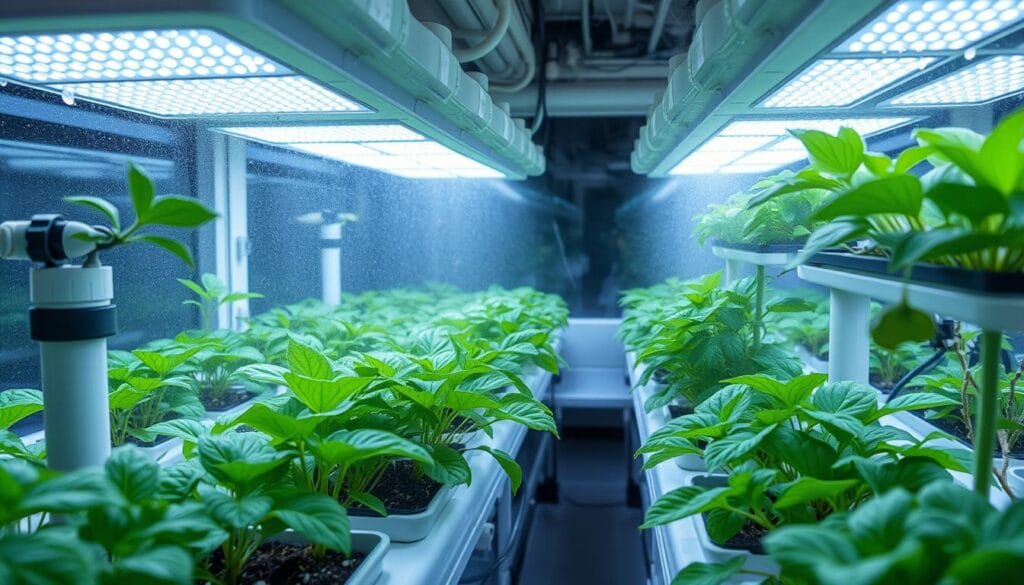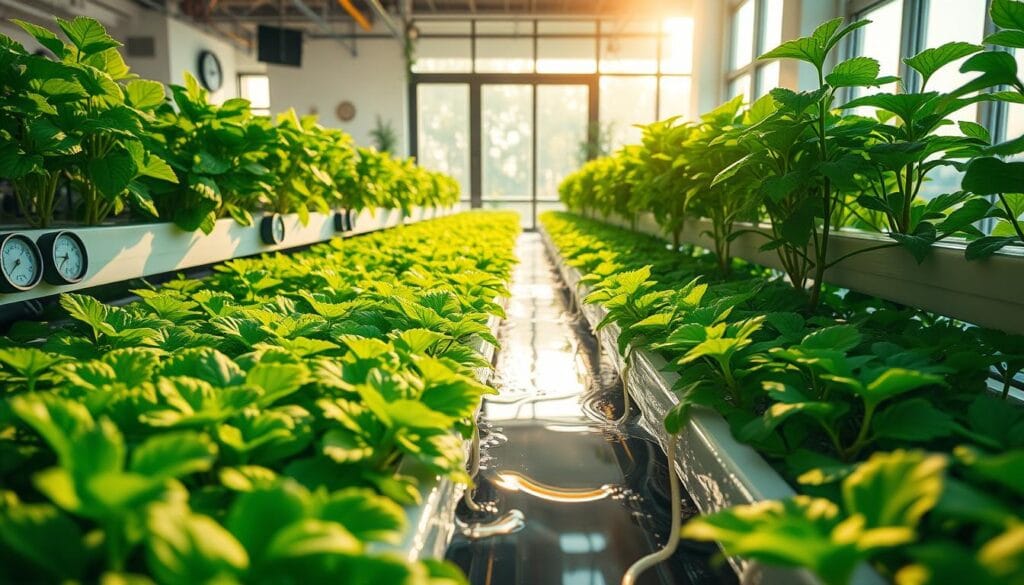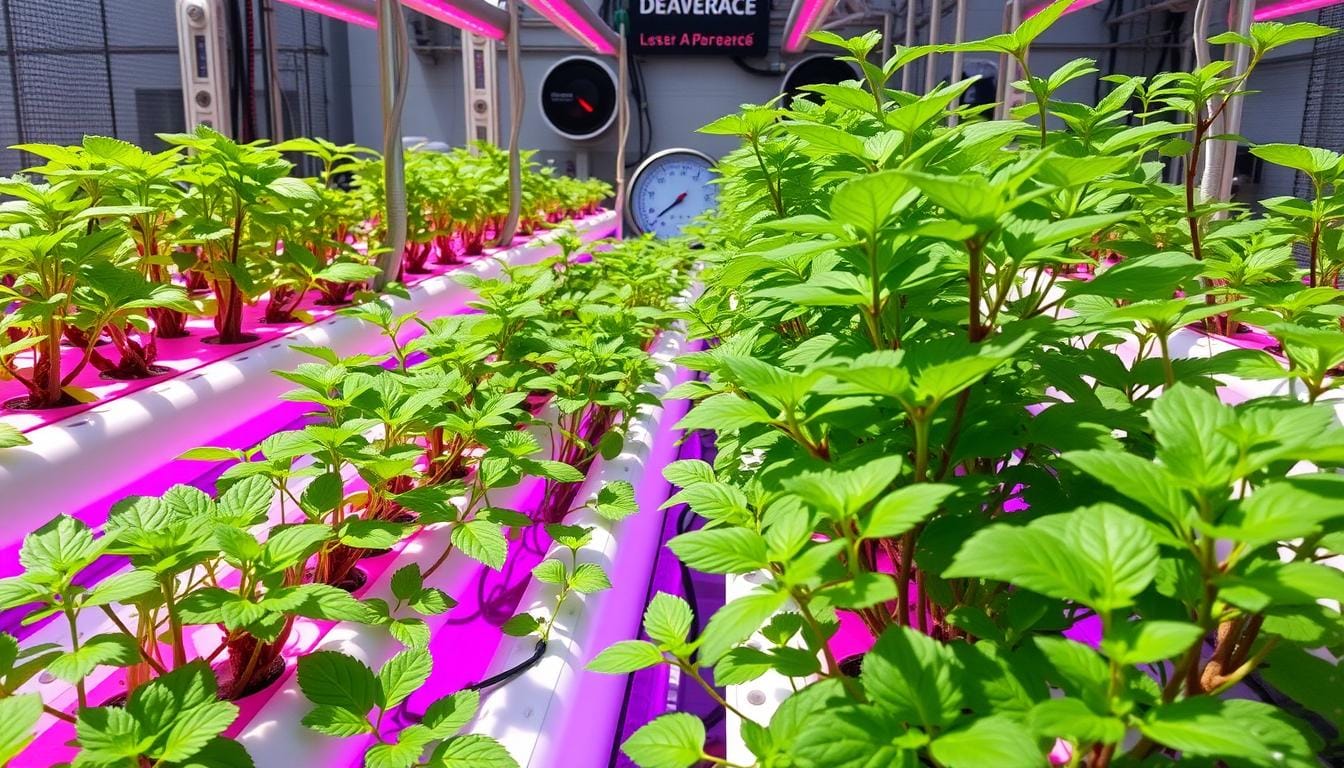Hydroponic farming is changing the game in indoor gardening. It doesn’t need soil and gives plants nutrients directly through water. To grow healthy hydroponic crops, keeping the right temperature and humidity is key.
The best temperature for most plants is between 65 to 80 degrees Fahrenheit. Humidity should be between 50% to 70%. It’s important to check and adjust these factors often. This ensures your hydroponic garden grows well and stays healthy.
Key Takeaways
- Proper temperature and humidity control are essential for successful hydroponic gardening.
- The ideal temperature range for most hydroponic crops is between 65-80°F (18-27°C).
- Humidity levels should be maintained between 50-70% to promote transpiration and nutrient uptake.
- Extreme temperatures and excessive humidity can negatively impact plant growth and health.
- Implementing climate control techniques, such as ventilation and dehumidification, can help optimize growing conditions.
Understanding the Fundamentals of Hydroponic Growing Systems
Hydroponic gardening is a way to grow plants without soil. Plants get their nutrients, oxygen, and water from a special solution. This method has been around since ancient times and is still used today in modern farms.
Types of Hydroponic Systems
There are many types of hydroponic systems. The nutrient film technique (NFT) uses a thin film of water for plants. Deep water culture (DWC) suspends plants in water. Aeroponics mist plants with water and nutrients.
Basic Components of a Hydroponic Setup
A hydroponic setup has a few key parts. These include grow lights, a reservoir for nutrient solution, pumps, and a growing medium like coco coir. Clean water from reverse osmosis is used for the nutrient solution.
Essential Environmental Factors
Hydroponic gardening needs careful control of several factors. These include light, temperature, humidity, CO2 levels, and air flow. By managing these, growers can ensure healthy plants and high yields.
| Hydroponic Crop | Annual Yield |
|---|---|
| Tomatoes | 394 lbs |
| Lettuce | 173 lbs |
| Basil | 88 lbs |
Knowing how to manage hydroponic systems, control the environment, and regulate the climate is key. It helps growers get great harvests and keep their gardens thriving.
Temperature and Humidity in Hydroponic Growth
In hydroponic gardening, temperature and humidity are key for plant health and growth. They affect photosynthesis, respiration, and water uptake. These are vital for plants to grow well and stay healthy.
Most plants do best in temperatures between 20-28°C. The mid-twenties are perfect for hydroponic growth. Fans help control temperature and humidity in the grow room. Artificial lighting is also important for indoor setups to ensure plants get the right light.
Humidity levels should be just above 50% in grow rooms. This prevents mold growth. It’s important to keep the room dry to avoid grey mold. Use hygrometers to check humidity and adjust as needed.
| Growth Stage | Ideal Relative Humidity Range |
|---|---|
| Seed Germination | 72% to 100% |
| Clones or Cuttings | 68% to 85% |
| Vegetating/Growth | 58% to 65% |
| Flowering/Bloom | 48% to 55% |
| Drying | 47% to 55% |
| Curing/Storing | 55% to 62% |
Managing temperature and humidity in your hydroponic grow room is crucial. It ensures your plants stay healthy and grow well. Proper control is essential for success in hydroponic temperature and humidity in hydroponic growth. It helps your plants thrive and gives you the best plant health and growth optimization.
The Science Behind Plant Temperature Requirements
Hydroponic growing needs a deep understanding of how plants and their ideal temperatures are connected. Each plant type has its own temperature needs. These affect their growth, how they take in nutrients, and their overall health.
Optimal Temperature Ranges for Different Plant Species
Hydroponic systems must be watched closely to meet each plant’s temperature needs. For example, research found that plants grow best at about 62.9% humidity. They also need specific air and root zone temperatures to thrive.
Knowing these temperature ranges helps growers create the best environment for their crops. This way, plants can grow well and produce more.
Impact of Temperature on Nutrient Uptake
Temperature is key for how plants absorb nutrients and work at their best. Studies show that temperature changes affect plant weights and how dense their leaves are. It also changes the levels of important nutrients like phosphorus and potassium.
Day vs. Night Temperature Management
It’s important to keep day and night temperatures different for plants to grow well. Daytime temperatures are usually 70-80°F (21-27°C). Nighttime temperatures are 10-15°F lower. This helps plants manage their energy use and grow efficiently.
“Hydroponic farming benefits from the ability to control the growing environment, including factors like temperature, humidity, and lighting.”
By grasping the science of plant temperature needs, hydroponic growers can make the perfect conditions for their crops. This leads to better yields and healthier plants.
Managing Humidity Levels in Your Hydroponic Garden
Keeping the right humidity is key for your hydroponic garden’s success. It helps prevent diseases, pests, and nutrient issues. Finding the perfect balance is essential for your plants’ health and growth.
Insufficient humidity can lead to wilting in plants and cause them to experience water stress. On the other hand, too much humidity can hinder nutrient uptake and lead to root rot. To keep your plants thriving, use a hygrometer to check humidity levels. You might need to use dehumidifiers, humidifiers, or improve air flow to get it just right.
- Most indoor plants do best in humidity levels between 40% and 60%.
- Adjusting humidity involves changing air flow, using humidifiers or dehumidifiers, or other methods.
- Use a hygrometer away from plants for accurate humidity readings.
- Good watering habits, like the “wet-dry” cycle, can also help manage humidity.
By watching and adjusting humidity in your hydroponic garden, you can help your plants grow their best. This approach also helps avoid problems caused by too much or too little moisture.

“Effectively managing humidity is essential for maximizing the growth and productivity of your hydroponic garden. It’s a delicate balance, but with the right techniques, you can create the perfect growing environment for your plants.”
By keeping the ideal humidity levels and considering environmental factors, you can boost your hydroponic garden’s yield and success.
Essential Tools for Climate Monitoring and Control
Keeping the right temperature and humidity is key for a successful hydroponic garden. You’ll need good climate monitoring and control tools. These include digital thermometers and automated controllers. They help make the perfect growing space for your plants.
Temperature Monitoring Devices
Getting accurate temperature readings is vital for managing the climate. Digital thermometers, wired or wireless, give you real-time data. This lets you adjust the environment as needed. Infrared sensors also measure surface temperatures, giving a full view of your system’s heat.
Humidity Control Equipment
Right humidity levels are as crucial as temperature for plant health. Use humidifiers and dehumidifiers to control air moisture. Foggers help increase humidity efficiently and precisely.
Automated Climate Control Systems
Automated systems offer the best in precision and ease. They use sensors and actuators to manage temperature, humidity, and more. These systems monitor and adjust conditions, giving you insights to improve your hydroponic setup.
| Tool | Purpose | Key Features |
|---|---|---|
| Digital Thermometer | Measure air temperature | Accurate readings, wireless options, data logging |
| Infrared Temperature Sensor | Measure surface temperatures | Non-contact measurement, temperature mapping |
| Humidifier | Increase air moisture | Adjustable humidity settings, automatic controls |
| Dehumidifier | Reduce air moisture | Precise humidity regulation, energy-efficient operation |
| Automated Climate Controller | Integrated climate management | Sensor inputs, actuator controls, data monitoring |
Investing in these climate tools is crucial for a thriving hydroponic garden. They ensure your plants are healthy and productive. Keep a close eye on temperature and humidity to maximize your hydroponic system’s potential.
Common Temperature-Related Issues and Solutions
Keeping the right temperature and humidity is key for a healthy hydroponic garden. Even experienced growers face temperature problems that can harm plants. Let’s look at common issues and how to solve them to keep your garden growing well.
Heat Stress
High temperatures can stress plants, causing them to wilt and grow poorly. To fight heat stress, make sure there’s good air flow with fans. If it gets too hot, think about using air conditioning or coolers.
Cold Damage
Cold can also hurt plants, slowing growth and changing leaf color. Use heaters or insulation to keep a steady, warm temperature in your garden.
Nutrient Uptake Challenges
Extreme temperatures make it hard for plants to take in nutrients. Watch the temperature closely and adjust it for your plants’ needs. This supports better nutrient absorption, helping plants remain healthy.
Fixing temperature problems fast is vital for your garden’s health. With the right cooling, heating, and climate control, you can give your plants the best place to grow.
“Proper temperature management is the cornerstone of a successful hydroponic system. By maintaining the ideal conditions, you unlock your plants’ full potential.”
Humidity Management Techniques for Maximum Yield
Keeping the right humidity levels is key for top growth and yields in hydroponics. Good humidity control helps plants grow well and avoids moisture problems. Let’s look at ways to manage humidity and boost your hydroponic yields.
Dehumidification Methods
Dehumidifiers are a main way to control too much humidity in hydroponics. They pull moisture from the air, keeping humidity just right for plants. Also, using fans to increase air flow helps moisture evaporate, lowering humidity.
Preventing Moisture-Related Problems
There are other steps to stop moisture issues in your hydroponic garden. Keep plants far enough apart for good air flow. Prune plants often and control algae in the growing medium to avoid mold and mildew. These steps help keep your garden healthy and free from moisture problems.
Seasonal Humidity Adjustments
The best humidity for your hydroponics can change with the seasons and plant growth stages. In hot, humid months, you might need to work harder to keep humidity down to avoid fungal diseases. In cooler, drier times, you might need to add more moisture to the air. It’s important to adjust humidity levels with the seasons to keep your plants happy all year.
Using these humidity management techniques can make your hydroponic garden thrive. Keep an eye on humidity, make changes as needed, and take a complete approach to humidity control. This will help you reach your hydroponic goals.
Optimizing Growth Through Environmental Control
To make your hydroponic garden a success, you need to focus on more than just temperature and humidity. Growth optimization, climate regulation, and managing other environmental factors are key. These steps can greatly improve your plant yields and garden’s overall productivity.
First, adjust the light intensity, spectrum, and duration for your plants’ needs. Studies show that changing the light spectrum can increase yields by up to 20%. Also, keeping CO2 levels around 1,000 ppm can boost growth by 10-30%.
Use monitoring devices and analytics to track your garden’s performance. This helps you make smart changes to your nutrient levels, irrigation, and more. It’s all about maximum growth optimization.
Try light spectrum changes and nutrient cycling to improve plant growth and yield. By creating the perfect climate-regulated space, you’ll unlock your hydroponic system’s full potential. Your garden will thrive and be very productive.
| Environmental Factor | Impact on Growth Optimization |
|---|---|
| Light Spectrum | Up to 20% increase in yields compared to broad-spectrum white light |
| CO2 Levels | 10-30% increase in plant growth with 1,000 ppm CO2 supplementation |
| Nutrient Cycling | Improved plant development and higher yields through optimized nutrient delivery |

“By creating an optimal climate-regulated environment, you can unlock the true potential of your hydroponic system and ensure a thriving, productive garden.”
The Relationship Between Temperature, Humidity, and Plant Health
In hydroponic gardening, keeping temperature and humidity in balance is key. This balance helps plants stay healthy and grow well. These factors affect how plants take in water and nutrients.
Temperature controls how fast plants lose water. If it’s too hot, plants lose too much water and get stressed. If it’s too cold, they can’t take in nutrients well, which slows growth.
Humidity affects the air’s moisture level. The right humidity helps plants manage their water and nutrient intake. This balance is crucial for healthy growth.
Knowing how temperature, humidity, and air moisture work together helps growers. They can adjust their climate control systems to meet each plant’s needs. This ensures plants grow well without stress.
Monitoring temperature and humidity, and using climate control tech, is vital. It helps your hydroponic garden reach its full potential. This leads to healthy, abundant harvests.
“Maintaining the right balance of temperature and humidity is crucial for the health and productivity of plants in a hydroponic system. Neglecting these environmental factors can lead to a range of issues, from stunted growth to pest infestations and disease outbreaks.”
Conclusion
Successful hydroponic growth depends on managing temperature and humidity well. It also needs other key environmental factors. By keeping an eye on these, growers can get consistent, high-quality crops all year. This way, they can also increase their yields.
It’s important to keep the temperature between 65-75°F (18-24°C) and humidity at 50-70%. Also, giving plants the right light, keeping pH levels correct, and balancing nutrients are crucial. These steps help your hydroponic garden grow healthy and productive.
By using the right environmental control, growers can boost their hydroponic growth success and yield maximization. They can also create a sustainable, high-performing environmental control system. Learning the art and science of hydroponic climate management lets you achieve great results consistently.

